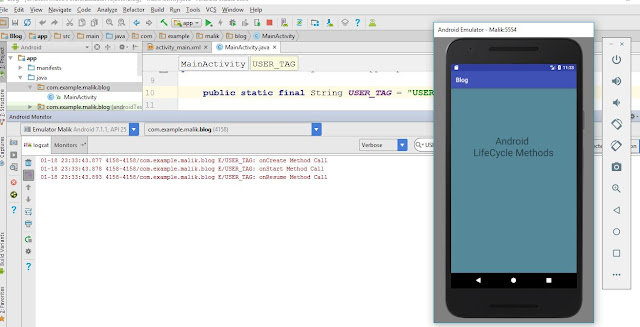Here we are going to learn lifecycle methods in android.
In Android Activity is controlled by 7 lifecycle methods.
If you have worked with C or C++ or Java programming then you must have seen that your program starts with main() function.
Main is the starting point of your program.
So, in android when activity opens your onCreate method will invoke first.
We have 7 lifecycle methods in android
onStart method called when activity is visible to the user.
onResume method called when user start interacting with the activity.
onPause method called when activity is not visible to the user.
onStop method called when activity is not visible to the user.
(Both onPause and onStop method call at the same time)
onRestart method called when user restart activity.
onDestroy method called when activity destroyed.
Let's see example ::
activity_main.xml
<?xml version="1.0" encoding="utf-8"?>
<LinearLayout xmlns:android="http://schemas.android.com/apk/res/android"
xmlns:app="http://schemas.android.com/apk/res-auto"
xmlns:tools="http://schemas.android.com/tools"
android:layout_width="match_parent"
android:layout_height="match_parent"
android:background="#589"
android:orientation="vertical"
tools:context=".MainActivity">
<TextView
android:layout_width="wrap_content"
android:layout_height="wrap_content"
android:layout_gravity="center"
android:layout_marginTop="150dp"
android:text=" Android \nLifeCycle Methods"
android:textSize="32sp"
/>
</LinearLayout>
In Android Activity is controlled by 7 lifecycle methods.
If you have worked with C or C++ or Java programming then you must have seen that your program starts with main() function.
Main is the starting point of your program.
So, in android when activity opens your onCreate method will invoke first.
We have 7 lifecycle methods in android
- onCreate
- onStart
- onResume
- onPause
- onStop
- onRestart
- onDestroy
onCreate methods called when activity is first opened or created.
onStart method called when activity is visible to the user.
onResume method called when user start interacting with the activity.
onPause method called when activity is not visible to the user.
onStop method called when activity is not visible to the user.
(Both onPause and onStop method call at the same time)
onRestart method called when user restart activity.
onDestroy method called when activity destroyed.
Let's see example ::
activity_main.xml
<?xml version="1.0" encoding="utf-8"?>
<LinearLayout xmlns:android="http://schemas.android.com/apk/res/android"
xmlns:app="http://schemas.android.com/apk/res-auto"
xmlns:tools="http://schemas.android.com/tools"
android:layout_width="match_parent"
android:layout_height="match_parent"
android:background="#589"
android:orientation="vertical"
tools:context=".MainActivity">
<TextView
android:layout_width="wrap_content"
android:layout_height="wrap_content"
android:layout_gravity="center"
android:layout_marginTop="150dp"
android:text=" Android \nLifeCycle Methods"
android:textSize="32sp"
/>
</LinearLayout>
MainActivity.java
package com.example.malik.blog;
import android.support.v7.app.AppCompatActivity;
import android.os.Bundle;
import android.util.Log;
public class MainActivity extends AppCompatActivity {
public static final String USER_TAG = "USER_TAG";
@Override
protected void onCreate(Bundle savedInstanceState) {
super.onCreate(savedInstanceState);
setContentView(R.layout.activity_main);
Log.e(USER_TAG, "onCreate Method Call");
}
@Override
protected void onStart() {
super.onStart();
Log.e(USER_TAG, "onStart Method Call");
}
@Override
protected void onResume() {
super.onResume();
Log.e(USER_TAG, "onResume Method Call");
}
@Override
protected void onPause() {
super.onPause();
Log.e(USER_TAG, "onPause Method Call");
}
@Override
protected void onStop() {
super.onStop();
Log.e(USER_TAG, "onStop Method Call");
}
@Override
protected void onRestart() {
super.onRestart();
Log.e(USER_TAG, "onRestart Method Call");
}
@Override
protected void onDestroy() {
super.onDestroy();
Log.e(USER_TAG, "onDestroy Method Call");
}
}
AndroidManifest.xml
<?xml version="1.0" encoding="utf-8"?>
<manifest xmlns:android="http://schemas.android.com/apk/res/android"
package="com.example.malik.blog">
<application
android:allowBackup="true"
android:icon="@mipmap/ic_launcher"
android:label="@string/app_name"
android:roundIcon="@mipmap/ic_launcher_round"
android:supportsRtl="true"
android:theme="@style/AppTheme">
<activity
android:name=".MainActivity"
android:screenOrientation="portrait">
<intent-filter>
<action android:name="android.intent.action.MAIN" />
<category android:name="android.intent.category.LAUNCHER" />
</intent-filter>
</activity>
</application>
</manifest>
build.gradle
apply plugin: 'com.android.application'
android {
compileSdkVersion 25
buildToolsVersion "25.0.2"
defaultConfig {
applicationId "com.example.malik.blog"
minSdkVersion 18
targetSdkVersion 25
versionCode 1
versionName "1.0"
testInstrumentationRunner "android.support.test.runner.AndroidJUnitRunner"
}
buildTypes {
release {
minifyEnabled false
proguardFiles getDefaultProguardFile('proguard-android.txt'), 'proguard-rules.pro'
}
}
}
dependencies {
compile fileTree(dir: 'libs', include: ['*.jar'])
androidTestCompile('com.android.support.test.espresso:espresso-core:2.2.2', {
exclude group: 'com.android.support', module: 'support-annotations'
})
compile 'com.android.support:appcompat-v7:25.3.1'
compile 'com.android.support.constraint:constraint-layout:1.0.2'
testCompile 'junit:junit:4.12'
}















